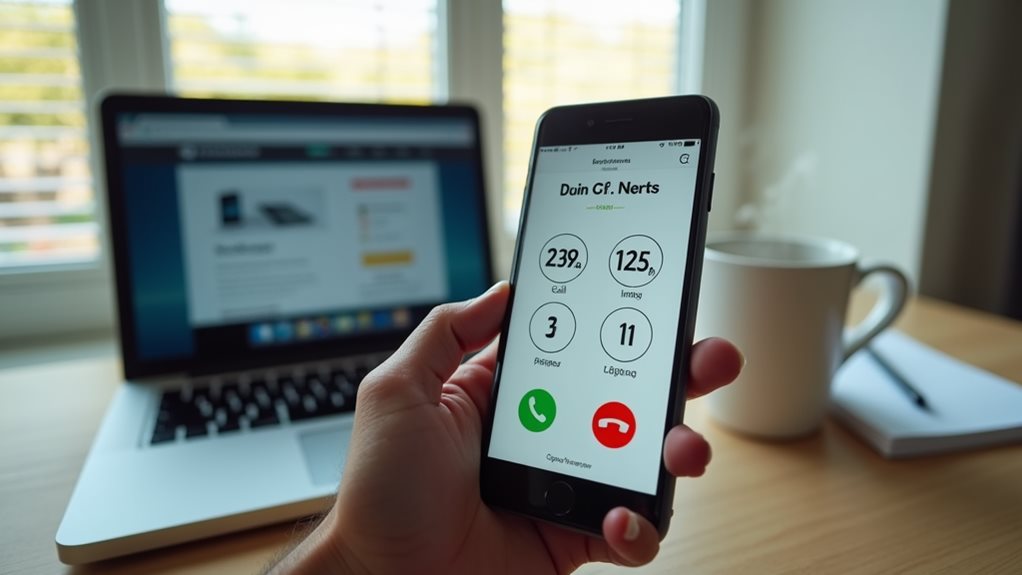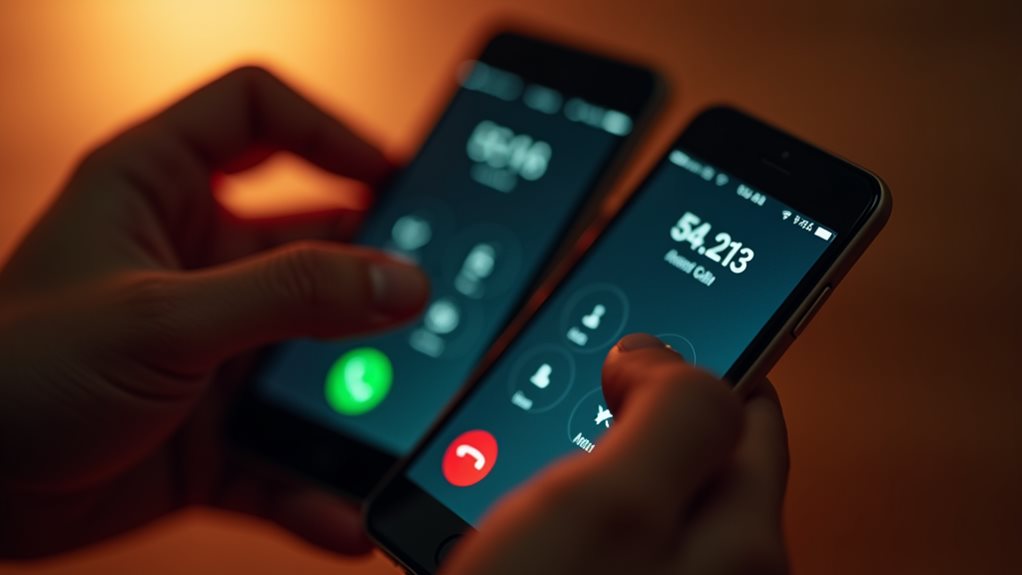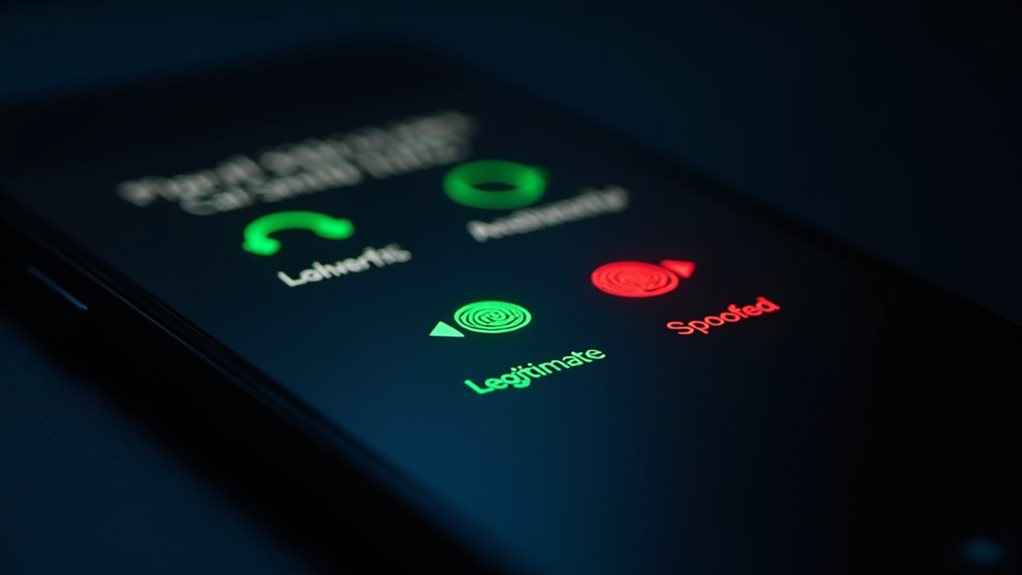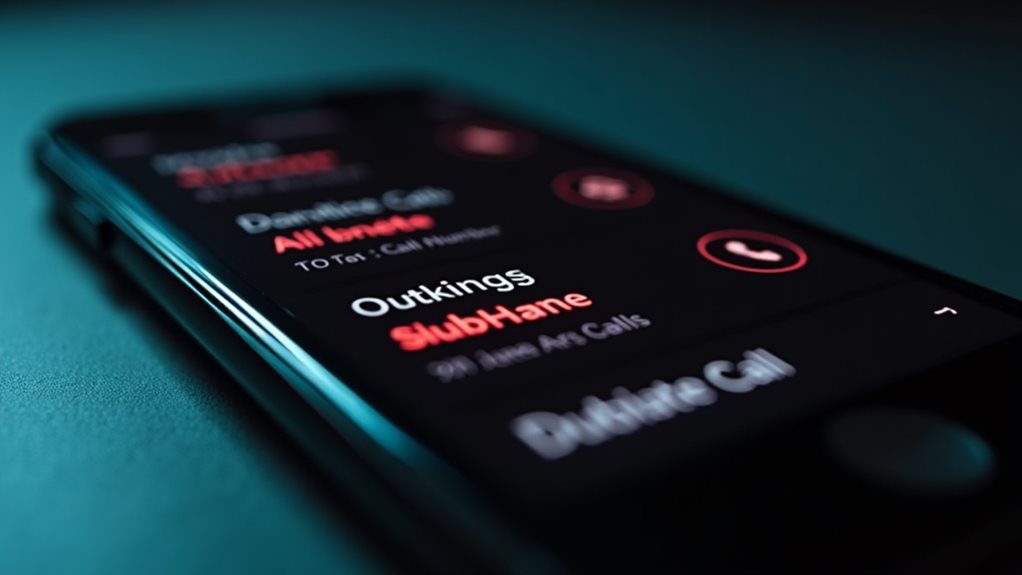If your number's been spoofed, act quickly by reporting the incident to your carrier, the FCC, and law enforcement. Don't engage with angry callers, but explain you're a victim of spoofing. Set up a voicemail message warning others about the situation, and enable enhanced security features through your carrier, including call blocking and STIR/SHAKEN verification. Consider using anti-spoofing apps and implementing SIM protection measures. There's much more you can do to protect your number and prevent future incidents.
Understanding Phone Number Spoofing
While phone number spoofing might sound like a complex technical term, it's actually a straightforward concept that's becoming increasingly common in today's digital world.
When someone spoofs your number, they're using various technologies, like VoIP services or PBX systems, to make their calls appear as if they're coming from your phone number. VoIP technology enables cost-effective communication, making it an attractive tool for scammers.
You'll find several types of spoofing methods being used, from sophisticated VoIP manipulation to social engineering tactics targeting phone company operators. The FCC has established that spoofing is only legal when used for legitimate purposes like protecting law enforcement or crisis hotline workers.
While it's concerning that these tools are readily available through various services and applications, understanding how spoofing works is your first step toward spoofing prevention.
What's particularly troubling is that this practice has become widespread, with millions of people affected and average losses exceeding $500 per incident in the United States alone.
The technology first gained mainstream attention when Star38.com launched its spoofing service in 2004, making it more accessible to the general public.
Recognizing Signs Your Number Has Been Spoofed
The unsettling realization that your phone number has been spoofed often begins with a puzzling series of complaints from strangers who claim you've called them.
Understanding common spoofing indicators can help you navigate this frustrating situation. You'll want to watch for signs like an increase in angry calls or texts from people you don't know, or reports that your number is displaying with unfamiliar business names. Recent data shows that phone scam losses exceeded $39.5 billion in just twelve months. Using VoIP technology, scammers can easily alter the caller ID information to impersonate your number, making it vital to be aware of call transfer fraud risk.
When identifying suspicious calls yourself, be wary of any caller who creates a sense of urgency or requests personal information.
Don't trust caller ID alone, as scammers can manipulate these displays using techniques like neighbor spoofing or orange boxing. If you're unsure about a call's legitimacy, hang up and contact the organization directly through their official channels to verify the communication.
Immediate Steps to Take After Discovering Spoofing

Once you've confirmed your number has been spoofed, taking swift and decisive action can help minimize potential damage and protect your identity. Start by immediately hanging up on any suspicious calls and avoid responding to questions that require simple yes or no answers. Consider using AI-powered spam blockers to help prevent future spoofing incidents. Additionally, many spam calls impersonate reputable companies that may lead to further confusion.
Your next immediate actions should focus on strengthening your defenses. Set up robust passwords on your voicemail accounts and enable caller verification features on your phone. Recording a voicemail message explaining the spoofing situation can help alert callers to block the number.
You'll want to notify your contacts about the situation, advising them to block the spoofed number and be cautious of unexpected calls. Don't forget to report the incident to your mobile carrier and consider filing a complaint with the FCC.
Legal Actions and Reporting Options
When you've confirmed your number is being spoofed, your first step should be filing a detailed complaint through the FCC's online Consumer Complaint Center, which helps build a documented case against the spoofer. Additionally, tracing VoIP numbers can aid in identifying the source of the spoofing and potentially linking it to other fraudulent activities.
You'll want to reach out to your local law enforcement agency, especially if the spoofing has resulted in harassing calls or threats to your safety. While law enforcement mightn't catch the spoofer immediately, your report creates an official record and could help identify patterns that lead to the perpetrator's arrest. Spoofing scams can result in fines up to $10,000 per violation when proven to be fraudulent or harmful.
Report to Law Enforcement
Taking legal action against phone spoofing starts with reporting the incident to proper law enforcement authorities.
When you're dealing with spoofing, proper reporting procedures and law enforcement collaboration are essential to combat these scams effectively. Spoofed calls often invoke high-pressure tactics, making it crucial to act swiftly.
The Los Angeles County Sheriff's Department warns that scammers frequently use phone number spoofing apps to make their calls appear legitimate.
You'll want to document all suspicious activity and follow these critical steps:
- Contact the DHS Office of Inspector General through their hotline at (800) 323-8603
- File a complaint with your local police department
- Submit a report to the Federal Trade Commission online
- Reach out to the FCC to document the spoofing incident
- Notify your state's consumer protection office
File FCC Complaint Online
A critical step in combating phone spoofing involves filing a formal complaint with the Federal Communications Commission (FCC).
You'll find the complaint process straightforward through online submission, where you can document the details of your case.
When filing your complaint, you'll need to provide your contact information and specific details about the spoofing incident, including the date, time, and nature of the call.
If you've experienced financial losses or compromised personal data, be sure to include this information as well.
The FCC takes these complaints seriously, with spoofers facing penalties up to $10,000 per violation.
Scammers outside U.S. often make enforcement challenging, but reporting helps track patterns of illegal activity.
You're not alone in this situation – the FCC provides extensive resources and guides to help you navigate the reporting process and protect yourself from future spoofing attempts.
Protecting Your Number From Future Spoofing

You'll need to take immediate steps to protect your SIM card and prevent unauthorized access to your phone number by contacting your carrier to set up security measures like port-out alerts and SIM swap protection. It may also be beneficial to obtain a non-VoIP number for secure communications, as these numbers enhance privacy and are generally less susceptible to spoofing attacks.
Consider using data removal services to reduce your vulnerability to spoofing attacks by removing your personal information from public databases. It's essential to monitor your phone activity regularly, keeping an eye out for suspicious calls or texts that might indicate your number is being misused.
Your vigilance, combined with these protective measures, will help create a strong defense against future spoofing attempts and maintain the security of your phone number.
Secure SIM Access Today
When it comes to protecting your phone number from future spoofing attempts, securing your SIM card access serves as your first line of defense.
By implementing robust SIM lock and PIN security measures, you'll create a strong barrier against unauthorized access to your phone number.
Take these essential steps to secure your SIM today:
- Enable your SIM card's PIN lock feature through your phone's security settings
- Create a unique PIN that isn't easily guessable, avoiding birth dates or sequential numbers
- Register your SIM with your mobile carrier for added protection against duplication
- Consider upgrading to an eSIM if your device supports it for enhanced security
- Set up two-factor authentication using an authenticator app rather than SMS verification
Additionally, be aware of VoIP security risks that can compromise your number's integrity, as hackers can exploit vulnerabilities to perform spoofing attacks.
These measures work together to markedly reduce your vulnerability to number spoofing and SIM-based attacks.
Monitor Your Phone Activity
Beyond securing your SIM card, staying vigilant about your phone activity serves as a powerful defense against number spoofing. Regular phone bill analysis helps you spot unauthorized charges, unfamiliar numbers, or unexpected service changes that might indicate spoofing. You'll want to report any discrepancies to your carrier immediately.
Implementing robust call tracking measures can greatly reduce your vulnerability. Install spam-filtering apps, enable carrier-provided screening services, and maintain detailed records of suspicious calls.
Don't forget to password-protect your voicemail and use *67 when making outbound calls to maintain privacy. When you receive calls from unknown numbers, let them go to voicemail and encourage legitimate callers to leave a message. Additionally, consider using Carrier Lookup services to identify potential spoofing sources and enhance your protection against fraudulent communications.
Working With Your Phone Carrier
Phone carriers serve as your first line of defense against number spoofing attacks. When you discover someone's spoofing your number, effective carrier communication becomes vital for resolving the issue.
Your provider has tools and protocols in place to help protect your identity and maintain spoofing awareness.
Contact your carrier immediately and take these essential steps:
- Report the specific details of spoofing incidents
- Request activation of enhanced call blocking features
- Inquire about STIR/SHAKEN verification services
- Ask about available anti-spam protection plans
- Document all suspicious calling activity
You'll find that most carriers offer extensive solutions to combat spoofing, including VoIP software and reverse number lookup capabilities. Additionally, being aware of VoIP scams can provide insights into prevalent tactics used by scammers.
Don't hesitate to explore additional security features, even if they come with extra fees – protecting your phone number is worth the investment.
Tools and Apps to Combat Number Spoofing

As technology evolves to combat phone scams, numerous tools and apps have emerged to help you protect your number from spoofing attacks.
You'll find reliable anti-spoofing apps like SpoofCard and Hushed that offer powerful features to mask your real number and maintain your privacy when making calls.
For enhanced security, consider implementing caller ID verification tools provided by major carriers and platforms like Plivo.
These services authenticate incoming calls and help you identify potential spoofing attempts before answering.
You can also explore extensive protection through apps that offer additional features like call recording and text masking. Understanding vulnerabilities in VoIP is crucial for selecting the right tools and protecting your communication.
Managing Communications With Affected Parties
When your phone number gets spoofed, managing communications with affected parties becomes a critical priority to minimize confusion and potential damage.
Your effective messaging strategies should focus on transparency and clear guidance. Managing caller expectations means you'll need to proactively address concerns while maintaining professional composure.
Here's what you'll want to communicate to those receiving spoofed calls from your number:
- Acknowledge that your number has been compromised and explain it's not coming from you
- Advise them to never share personal information with unexpected callers
- Suggest they verify authenticity by calling official numbers directly
- Recommend reporting suspicious calls to their service providers
- Encourage them to hang up if pressured for immediate responses
Security Best Practices for Phone Numbers

Implementing robust security measures for your phone number has become increasingly critical in today's interconnected world.
To enhance your phone security, start by setting up a Telco PIN with your service provider and enrolling in their specialized protection services. You'll also want to regularly update your device's software and carefully manage app permissions to prevent unauthorized access.
For extensive number protection, consider using encrypted DNS services and installing anti-spoofing apps.
Don't forget to register for the National Do Not Call Registry and limit sharing your contact information online. When possible, use private numbers or masking services to add an extra layer of security.
Remember to monitor your account activity regularly and verify any suspicious calls by encouraging callbacks through official channels.
Frequently Asked Questions
Can Spoofed Calls Be Traced Back to Their Actual Source?
Yes, you can trace spoofed calls through your telecom provider's call tracing services, but you'll need to act quickly. For legal ramifications, you should involve law enforcement, especially if fraud is suspected.
How Long Does Number Spoofing Typically Last Once It Starts?
You'll typically experience temporary effects of number spoofing for hours to several days. The duration factors vary based on scammers' patterns, but they often switch numbers frequently to avoid detection and maintain their schemes.
Will Changing My Phone Number Guarantee Protection Against Future Spoofing?
No, changing your number won't guarantee protection from future spoofing. You'll still need to maintain strong number security and use call verification features. We all face these risks in today's connected world.
Can Spoofers Access My Text Messages and Voicemails Through Number Spoofing?
No, spoofers can't directly access your text messages or voicemails through number spoofing alone. However, you'll want strong text message security and voicemail protection with passwords to prevent unauthorized access through other methods.
Does Having a Business Number Make Me More Vulnerable to Spoofing?
Yes, your business number has increased vulnerability to spoofing since criminals view it as a lucrative target. But don't worry – you can reduce risks through strong spoofing prevention measures like authentication and monitoring.
Final Thoughts
Protecting your phone number from spoofing isn't just about immediate action—it's an ongoing commitment to security. You'll need to stay vigilant, maintain strong privacy practices, and work closely with your carrier to prevent future incidents. While you can't completely eliminate the risk of number spoofing, combining preventive measures, quick responses, and the right security tools will help you maintain control of your phone identity and protect your communications.

